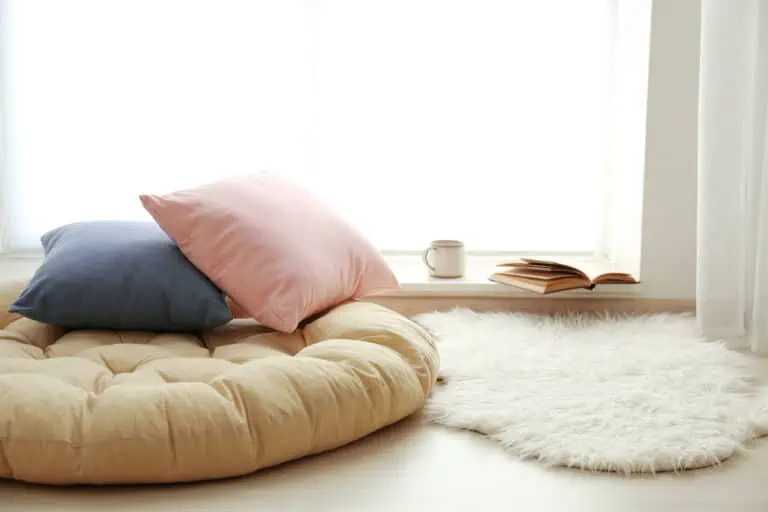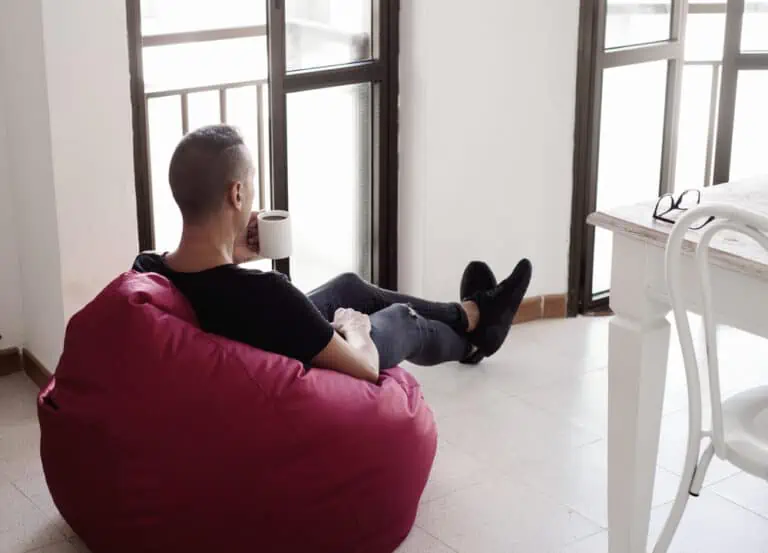What to Fill a Bean Bag With (9 Options to Consider)
Homebody Forever is reader-supported. We may receive a commission if you make a purchase through a link on this post.
You’re setting up your cozy reading nook and have your rugs, plants, floor cushions, and bean bag cover.
Now it’s time to fill your bean bags so you can enjoy them.

If you’re anything like me, you typed “bean bag fillings” into Google to see what you can order online. And then quickly realized that bean bag fillings come in all sorts of materials, and you have no idea which one you should choose.
Well, that’s what this article is for. Read on to learn more about what you can find in the market, and which fillings might be best for you.
- EPS and EPP beads are the most common fillings. Either of these are great options if you’re on a budget and want something durable.
- If you want your bean bag to have more of a ‘sofa’ feel, require more support, and are willing to pay a little bit extra then shredded foam is your best option.
- For environmentally-friendly options, you can also opt for natural fillings like buckwheat hulls or rice. Keep in mind, however, that they won’t be as comfortable or durable as synthetic fillings.
Expanded Polystyrene (EPS) Beads
EPS beads are a very common filling for bean bags. It is a type of foam made out of polystyrene—a type of plastic.
EPS beads are lightweight, affordable, and provide a comfortable seating experience because they can mold to the shape of your body when you sit on them. It’s also resistant to heat and moisture, so you don’t have to worry about attracting pests.
On the not-so-positive side, EPS beads can lose its shape over time because it tends to compress. Like any plastic material, it can be flammable. And while some places will recycle EPS beads, it’s not biodegradable, so it’s not the most environmentally-friendly option.
Expanded Polypropylene (EPP) Beads
Expanded polypropylene (EPP) is another common filling for bean bags.
EPP beads are lightweight, durable, and resilient. It’s also resistant to moisture, chemicals, and temperature changes, so it won’t get moldy or break down over time.
One of the biggest advantages of EPP beads is durability. EPP beads are incredibly strong and can withstand much pressure without losing shape or breaking down. If you plan on using your bean bags a lot and want to keep it for a long time, it is an excellent choice. And while EPP beads can compress, it can revert to its original shape.
Of course, there are some drawbacks to EPP beads. Compared to fillers like shredded memory foam (which we’ll cover below), it isn’t as comfortable or plush. It can have the potential to degrade when exposed to oxygen. And because it’s a form of plastic, it’s not biodegradable (although it’s worth noting that it’s much easier to recycle than EPS beads).

Shredded Foam
Shredded foam is another popular option for bean bag fillings. It is highly adaptable and takes the shape of your body, providing a comfortable seating experience. Shredded foam comprises small pieces of polyurethane foam that are shredded into small pieces and then packed into the bean bag cover.
You’ll find shredded foam inside your couch, mattress, or cushion. It’s heavier than EPP or EPS beads, which is good if you want your bean bag to have the traditional feel of a sofa (but not great if you plan to move your bean bag around).
With shredded foam, you do have the option of choosing your support level and surface feel. Higher-density foam, for example, will typically provide more support than lower-density foam. Smaller pieces will create a smoother surface, while larger pieces can create a more lumpy surface.
They tend to be pricier than EPP or EPS beads and retain more heat. And while they’re not biodegradable, they can be a more environmentally-friendly option as more and more manufacturers are making shredded foam out of recycled foam and materials.
Memory Foam
Memory foam is typically made of the same materials as shredded foam but has not been sliced or cut into small pieces. It also contains additional chemicals that increase its viscosity or density. You’ll often find them in mattresses and pillows.
Memory refers to its ability to return to its original form once when you’re not sitting (or lying) on it. It’s durable, long-lasting, and commonly hypoallergenic, making it an excellent option for allergy sufferers. Like shredded foam, you can choose your level of support depending on how dense it is.
As for the downsides, memory foam tends to be more expensive than EPP or EPS beads. And because it’s also on the heavier side, it doesn’t ‘mold’ as quickly to your body the way that you expect a bean bag to.
Microbeads
Microbeads are small, round beads made of plastic—often polyethylene terephthalate, as well as polypropylene and polystyrene. They’re significantly smaller than EPP or EPS beads.
You’ll often see microbeads in pillows and stuffed animals, but you can also use it as a bean bag filling. Microbeads provide a comfortable seating experience and are easy to mold into different shapes.
Because of its size, it provides a different feel to larger beads and shredded foams. Microbeads are heavier than EPP or EPS beads but lighter than shredded foam.
The biggest downside to microbeads is their potential environmental impact. It’s not biodegradable, and its presence in our rivers, lakes, and oceans can negatively impact marine life due to its ability to absorb toxins. They also tend to flatten over time, which can cause your bean bag to lose its shape and support.
Natural Fillings
By now, you might be wondering, is there such thing as an environmentally-friendly bean bag filling?
The answer is yes. Here are some of the most popular natural fillings for bean bags:
Buckwheat Hulls
Buckwheat hulls are lightweight and provide a comfortable and supportive seating experience. Buckwheat hulls are also hypoallergenic, making them a good choice for those with allergies. However, they can be noisy when you move around on the bean bag.
Rice
Rice is another affordable and readily available option. However, it’s not supportive as some other fillings, so it might not be the most comfortable option.

Corn
Corn is another affordable and eco-friendly option for bean bag fillings. It is lightweight and provides a comfortable seating experience. It can, however, have the potential to attract pests.
Kapok Fiber
Kapok fiber is a natural filling that comes from the seed pods of the kapok tree. It is a lightweight, comfortable filling with good support and feels similar to down feathers. Kapok fiber is also hypoallergenic, making it a good choice for those with allergies.
While its soft fluffy nature might make it an excellent option for pillows and cushions, it might not work as well with bean bags. When you sit on kapok-fiber-filled bean bags, it likely won’t be as malleable as a beads-filled bean bag would.
Now, the biggest upside to choosing natural filling is obviously its eco-friendly and sustainable nature.
It’s worth noting, though, that they’re not as comfortable as synthetic fillings. And because biodegradable things aren’t durable, you’ll have to be prepare to replace them more often than you would with synthetic fillings.






